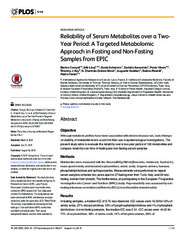| dc.description.abstract | Objective
Although metabolic profiles have been associated with chronic disease risk, lack of temporal
stability of metabolite levels could limit their use in epidemiological investigations. The
present study aims to evaluate the reliability over a two-year period of 158 metabolites and
compare reliability over time in fasting and non-fasting serum samples.
<p>Methods
Metabolites were measured with the AbsolueIDQp180 kit (Biocrates, Innsbruck, Austria) by
mass spectrometry and included acylcarnitines, amino acids, biogenic amines, hexoses,
phosphatidylcholines and sphingomyelins. Measurements were performed on repeat
serum samples collected two years apart in 27 fasting men from Turin, Italy, and 39 nonfasting
women from Utrecht, The Netherlands, all participating in the European Prospective
Investigation into Cancer and Nutrition (EPIC) study. Reproducibility was assessed by estimating
intraclass correlation coefficients (ICCs) in multivariable mixed models.
<p>Results
In fasting samples, a median ICC of 0.70 was observed. ICC values were <0.50 for 48% of
amino acids, 27% of acylcarnitines, 18% of lysophosphatidylcholines and 4% of phosphatidylcholines.
In non-fasting samples, the median ICC was 0.54. ICC values were <0.50 for
71% of acylcarnitines, 48% of amino acids, 44% of biogenic amines, 36% of sphingomyelins, 34% of phosphatidylcholines and 33% of lysophosphatidylcholines. Overall,
reproducibility was lower in non-fasting as compared to fasting samples, with a statistically
significant difference for 19–36% of acylcarnitines, phosphatidylcholines and
sphingomyelins.
<p>Conclusion
A single measurement per individual may be sufficient for the study of 73% and 52% of the
metabolites showing ICCs >0.50 in fasting and non-fasting samples, respectively. ICCs
were higher in fasting samples that are preferable to non-fasting. | en_US |


 English
English norsk
norsk